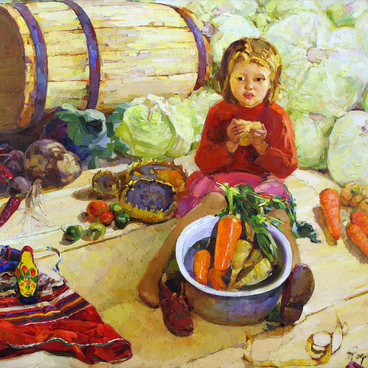An Honored Artist of the Republic of Mordovia, Alexander Zhidkov (1935–2020) graduated from the Konstantin Savitsky Art School in Penza in 1961. Along with his colleagues Viktor Bednov and Anatoly Misyura, he traveled a lot around Mordovia, worked as a designer and at the same time collected material for future works. On these creative work trips, he painted his picturesque landscapes of local villages, portraits of contemporaries, and thematic paintings.
In painting, Alexander Zhidkov relied on the principles developed by the “Severe style” artists. This style was formed in the 1950s and offered a monumental depiction of hard workdays. The focus was on the harsh, unembellished romance of everyday life and people with their inner strength, energy and will to live. Although Alexander Zhidkov was inspired by the Severe aesthetics, his canvases differ from the textbook works of this style. His paintings are cheerful, and replete with many interesting details. Zhidkov often used bright colors, reminiscent of fairy-tales.
The heroine of the painting “Spring” is dressed in a red Moksha costume, which was widespread in Mordovia in the middle of the 20th century. The bright dress and the colorful blanket in which the mother holds her child contrast with the dark color of the father’s clothes. The composition is built on juxtapositions: the rough boots and the delicate geranium branches in the window, the strong figures and the thin young tree.
Alexander Zhidkov translates this seemingly genre painting into the realm of allegory. The two central figures represent two different manifestations of life: the man symbolizes harsh working days, the woman — traditions. The image of the child introduces the idea of the continuity of generations.
The painting illustrates in an allegorical form the well-known saying that in life one has to “build a house, plant a tree, and raise a son”. The couple and the baby are depicted against the background of a new log house, the man leans on a shovel — he has just planted a new sapling.
The spring in the picture is not just a season. The newborn baby, the newly planted tree, and the sunny, vivid colors indicate to us that the spring is the beginning of a new life, a time for new achievements.
In painting, Alexander Zhidkov relied on the principles developed by the “Severe style” artists. This style was formed in the 1950s and offered a monumental depiction of hard workdays. The focus was on the harsh, unembellished romance of everyday life and people with their inner strength, energy and will to live. Although Alexander Zhidkov was inspired by the Severe aesthetics, his canvases differ from the textbook works of this style. His paintings are cheerful, and replete with many interesting details. Zhidkov often used bright colors, reminiscent of fairy-tales.
The heroine of the painting “Spring” is dressed in a red Moksha costume, which was widespread in Mordovia in the middle of the 20th century. The bright dress and the colorful blanket in which the mother holds her child contrast with the dark color of the father’s clothes. The composition is built on juxtapositions: the rough boots and the delicate geranium branches in the window, the strong figures and the thin young tree.
Alexander Zhidkov translates this seemingly genre painting into the realm of allegory. The two central figures represent two different manifestations of life: the man symbolizes harsh working days, the woman — traditions. The image of the child introduces the idea of the continuity of generations.
The painting illustrates in an allegorical form the well-known saying that in life one has to “build a house, plant a tree, and raise a son”. The couple and the baby are depicted against the background of a new log house, the man leans on a shovel — he has just planted a new sapling.
The spring in the picture is not just a season. The newborn baby, the newly planted tree, and the sunny, vivid colors indicate to us that the spring is the beginning of a new life, a time for new achievements.


